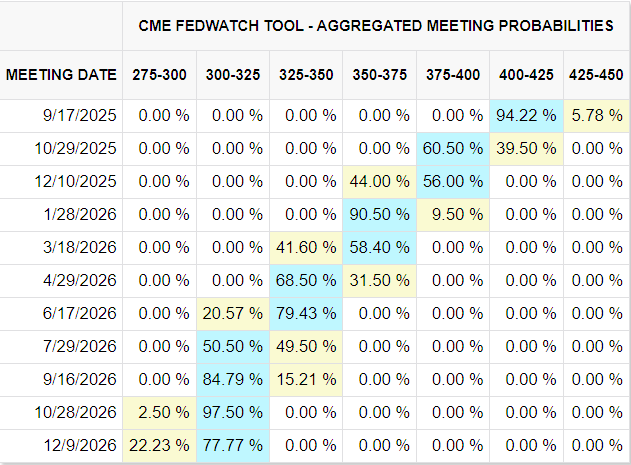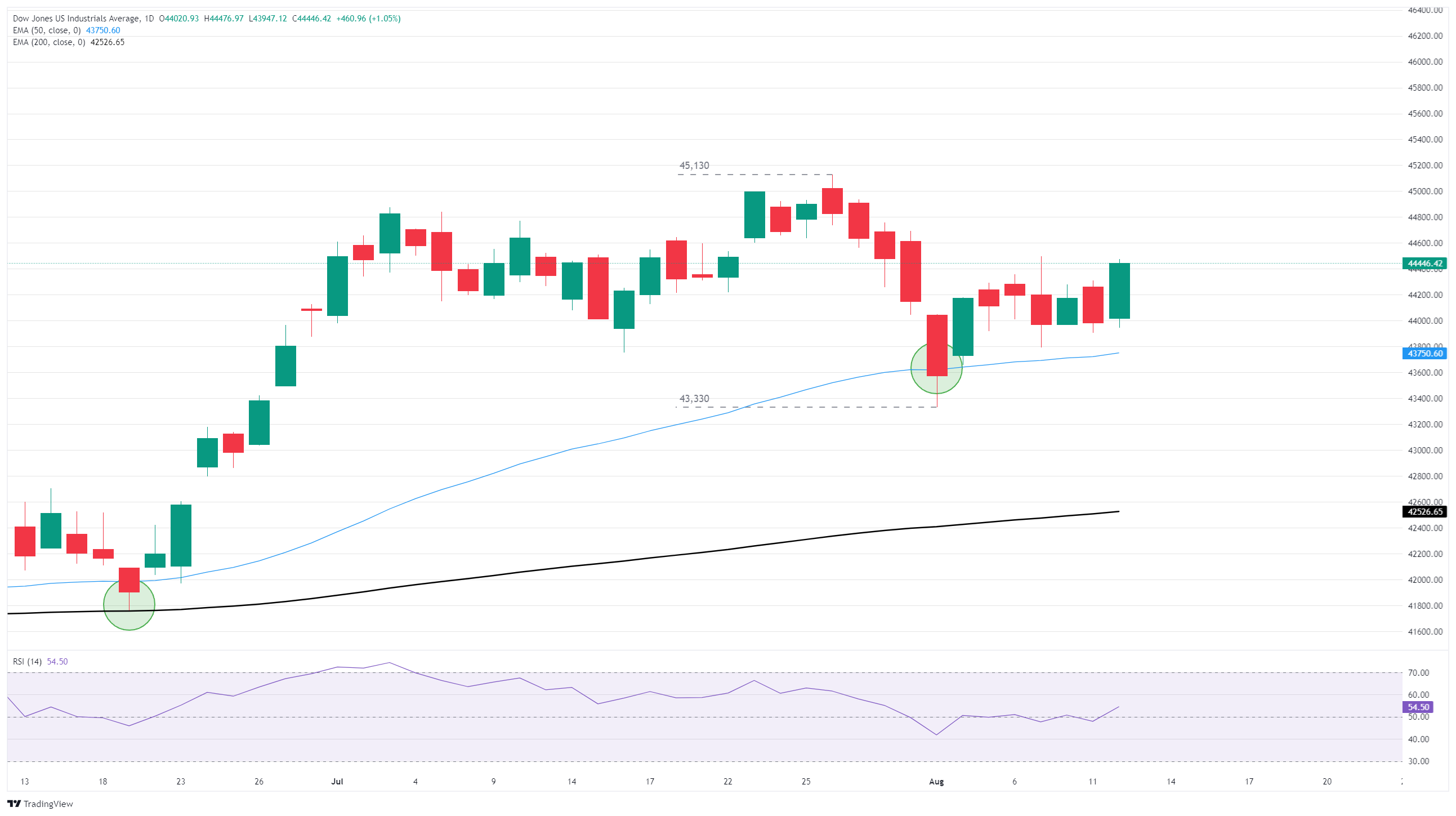Created
: 2025.08.13














![]() 2025.08.13 03:03
2025.08.13 03:03
The Dow Jones Industrial Average (DJIA) caught some bullish lift on Tuesday, rising around 450 points after United States (US) Consumer Price Index (CPI) inflation data from July failed to push markets off of bets for an interest rate cut from the Federal Reserve (Fed) in September.
The Dow bounced back above 44,400 to punch in a new high for the week and pushed into the high end of near-term consolidation. The Dow Jones is still catching some lift following a bullish bounce from the 50-day Exponential Moving Average (EMA), which is now rising into 43,800, and the trick for bidders will be to muscle the major index back above 44,500. Should bullish momentum falter here, the Dow could backslide into a firm consolidation phase.

Headline CPI inflation came in better than expected, holding steady at 2.7% YoY in July versus the expected uptick to 2.8%. Despite investors maintaining their positive mood following the CPI release, the figure indicates that there has been no functional progress in taming headline CPI inflation since September 2024. Core CPI metrics further pointed to potential issues, with inflation minus volatile food and energy prices accelerating to 3.1% YoY, wiping out six months of minimal progress on core inflation.
Despite still-stubborn inflation data, investors are still leaning firmly into bets of a Fed rate cut on September 17. According to the CME FedWatch Tool, rate betters see nearly 95% odds of at least a quarter-point rate trim at the Fed's next interest rate decision. Odds of a follow-up rate cut in October also climbed above 60%, and rate traders have priced in 90% odds that the Fed will reach three-quarters of a point in rate cuts by the end of next January.

Not to be outdone by market headlines, US President Donald Trump announced that not only is Fed Chair Jerome Powell "too slow" to deliver interest rates, he is considering allowing a legal case to proceed against the head of the Fed, whom he himself nominated for the position during his first term. According to Trump, the costs of the Fed building restoration, which is paid by neither the taxpayers nor the government, has become "too expensive", which Trump ostensibly intends to use as justification for suing Fed Chair Powell for refusing to lower interest rates. Apparently, the Trump administration remains unaware that the Federal Open Market Committee (FOMC) sets rates via a majority vote at regularly scheduled meetings throughout the calendar year.
Seeding clouds to make a rainy day later, Trump's pick to head the Bureau of Labor Statistics (BLS) suggested in an interview with Fox News that the BLS should pause publishing monthly labor data. EJ Antoni, the chief economist of the conservative political campaign group Heritage Foundation, was tapped by Donald Trump to replace the head of the BLS, whom Trump had terminated in a whiplash reaction to the latest sour patch of US labor data.


The Dow Jones Industrial Average, one of the oldest stock market indices in the world, is compiled of the 30 most traded stocks in the US. The index is price-weighted rather than weighted by capitalization. It is calculated by summing the prices of the constituent stocks and dividing them by a factor, currently 0.152. The index was founded by Charles Dow, who also founded the Wall Street Journal. In later years it has been criticized for not being broadly representative enough because it only tracks 30 conglomerates, unlike broader indices such as the S&P 500.
Many different factors drive the Dow Jones Industrial Average (DJIA). The aggregate performance of the component companies revealed in quarterly company earnings reports is the main one. US and global macroeconomic data also contributes as it impacts on investor sentiment. The level of interest rates, set by the Federal Reserve (Fed), also influences the DJIA as it affects the cost of credit, on which many corporations are heavily reliant. Therefore, inflation can be a major driver as well as other metrics which impact the Fed decisions.
Dow Theory is a method for identifying the primary trend of the stock market developed by Charles Dow. A key step is to compare the direction of the Dow Jones Industrial Average (DJIA) and the Dow Jones Transportation Average (DJTA) and only follow trends where both are moving in the same direction. Volume is a confirmatory criteria. The theory uses elements of peak and trough analysis. Dow's theory posits three trend phases: accumulation, when smart money starts buying or selling; public participation, when the wider public joins in; and distribution, when the smart money exits.
There are a number of ways to trade the DJIA. One is to use ETFs which allow investors to trade the DJIA as a single security, rather than having to buy shares in all 30 constituent companies. A leading example is the SPDR Dow Jones Industrial Average ETF (DIA). DJIA futures contracts enable traders to speculate on the future value of the index and Options provide the right, but not the obligation, to buy or sell the index at a predetermined price in the future. Mutual funds enable investors to buy a share of a diversified portfolio of DJIA stocks thus providing exposure to the overall index.
![]()
Created
: 2025.08.13
![]()
Last updated
: 2025.08.13

FXStreet is a forex information website, delivering market analysis and news articles 24/7.
It features a number of articles contributed by well-known analysts, in addition to the ones by its editorial team.
Founded in 2000 by Francesc Riverola, a Spanish economist, it has grown to become a world-renowned information website.
We hope you find this article useful. Any comments or suggestions will be greatly appreciated.
We are also looking for writers with extensive experience in forex and crypto to join us.
please contact us at [email protected].
Disclaimer:
All information and content provided on this website is provided for informational purposes only and is not intended to solicit any investment. Although all efforts are made in order to ensure that the information is correct, no guarantee is provided for the accuracy of any content on this website. Any decision made shall be the responsibility of the investor and Myforex does not take any responsibility whatsoever regarding the use of any information provided herein.
The content provided on this website belongs to Myforex and, where stated, the relevant licensors. All rights are reserved by Myforex and the relevant licensors, and no content of this website, whether in full or in part, shall be copied or displayed elsewhere without the explicit written permission of the relevant copyright holder. If you wish to use any part of the content provided on this website, please ensure that you contact Myforex.
Myforex uses cookies to improve the convenience and functionality of this website. This website may include cookies not only by us but also by third parties (advertisers, log analysts, etc.) for the purpose of tracking the activities of users. Cookie policy